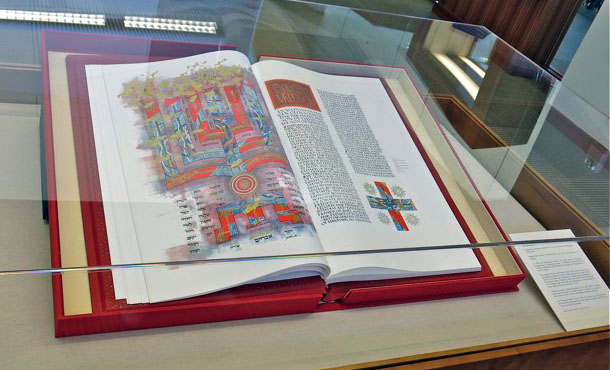
In July 2000, I was visiting Dublin, Ireland, and went with a friend to the historic campus of Trinity College. There we waited in a queue at the Old Library and were ushered into a darkened room, in the middle of which were lighted display cases.
Our reward was to view beautiful manuscripts dating from the ninth century: The Book of Kells. Written on vellum (prepared calfskin) and lavishly decorated, these two volumes on display were illustrated in the style known as illumination.
This was my first experience viewing the sacred texts (writings held in reverence by a religious group); apparently I was one of a half-million visitors that year. I thought back to that experience when I heard of a sacred text exhibit at Santa Clara University that closes on June 30. Housed on the third floor of the Harrington Learning Commons, admission is free. Call (408) 551-1951 for more information.
“An Exhibit of Sacred Texts Past, Present and Future” brings together “contemporary artists working in a variety of media to engage the unfolding dynamic of sacred texts.” Ancient and modern holy books and objects from many different religious traditions are also included. Several were particularly interesting, including:
• A 27-foot prayer rope
• Photos of prayer books and Bibles from flooded churches after Hurricane Katrina
• An 18th century illuminated (hand decorated) Qur’an
• An illuminated bicentennial edition of the U.S. Constitution
• A modern scroll of the Book of Esther
• An accordion-fold Hindu prayer book in Sanskrit from the early 19th century
• Drawings that show scenes from contemporary American life to illustrate “suras” (divisions, like chapters) from the Qur’an.
According to Curator Michelle Townsend, the exhibit seeks to answer such questions as:
• What matters most about sacred text, the object or the content?
• Is a sacred text still sacred when it is altered or transformed?
Earlier this year the university held a series of lectures exploring the public significance of sacred texts from different faith traditions. Several of the speakers were people who regularly represent their faiths in public forums, such as Ravi Gupta, a Hindu who met with Pope Benedict XVI during his first visit to the United States, and Ingrid Mattson, who spoke at President Obama’s first inaugural interfaith prayer service.
Hateful videos have caused riots in the Mideast, and the American public often exhibits limited understanding of and tolerance for minority religions. The goal of this speaker series was to “go beyond polarizing rhetoric and seek to promote dialogue across religious traditions.”
The art exhibit and lectures were sponsored by the Ignatian Center for Jesuit Education, named for the founder of the Society of Jesus (the official name of the Jesuit Order). St. Ignatius Loyola was a 16th century Spanish soldier from a noble family who devoted his order to defending the Church during the time of the Reformation and missionary work. Today Jesuits are probably best-known for their educational endeavors; there are 28 Jesuit colleges and universities in the United States.
The center promotes the “distinctive Jesuit, Catholic tradition” of Santa Clara University and seeks to provide leadership for the “integration of faith, justice and intellectual life through four signature programs.” For more information, visit www.scu.edu/ignatiancenter.









